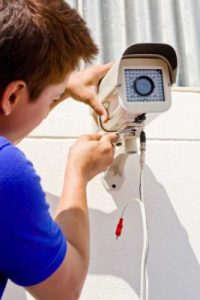Planning is very essential before installing CCTV system in your desired location. You need to choose the right location of the cameras and DVR so that the camera covers all the area which you want to monitor while minimizing the cable requirement. When you are installing the cameras indoors, choose the camera locations such that all the entry points to the room are covered. If it is a shop you want to monitor, choose the locations such that the counters as well as the racks of goods are covered. If you are monitoring the outdoors, choose a location such that the doors, the garage, front, etc are covered. Also the outdoor camera should be at a height such that it cannot be easily knocked down.

Once you are done with the planning, you must obtain the materials required for CCTV installation. VelaCCTV provides all kinds of equipment necessary to install CCTV. If you need expert help in choosing the right CCTV materials for securing your home, office, business or other places, you have come to the right place. For CCTV installation and configuration also there is no better place other than VelaCCTV. The materials required for installing CCTV are
-
CCTV cameras
-
DVR/NVR/CCTV recorder
-
Monitor
-
CCTV cables, RJ59 Siamese cable being the most common
-
LAN cable if connecting to the internet
-
Monitor cables
-
BNC connectors
-
Power supply and appropriate power supply cables
Fixing the cameras and DVR:
Once you have all the equipments required, its time to fix the cameras to their desired location. Position the cameras on the wall or ceiling and mark the points for drilling. Drill holes in the marked places and hammer in the screw moldings. Now place the camera and tighten the screws. Your cameras are set in the position. Its time to put the DVR in the desired location. Put the DVR in a place securely locked away so that no miscreants can access the DVR. The DVR contains the hard drive which holds the video recording and so it must be secured properly. When you have put the DVR make sure that it is connected easily to a power supply.
Cabling the cameras:
Now is the cabling part. The cables come with two 18 gauge wires. Simply connect them to the appropriate cables coming from the CCTV camera. Plan the path through which the cables would come from the camera to the DVR. Use wire moldings to cover the cables and nail the moldings to the walls with the camera cables inside. Connect the DVR end of the camera cable to a BNC connector. Simply remove about 1.5 cm of outer covering of the RJ59 cable, exposing the braids. Slide the crimping barrel onto the cable. Remove the covering of the innermost cable. Insert the exposed cables into the BNC port and screw the crimping barrel.
Connect the monitor to the DVR and power on the system.
Installation processes are always painstaking & tedious. As far our other products are concerned, you can read about Video Door Phone System Installation process which is also very interesting to learn.
